Welcome to Hot Pets News, where we bring you the juiciest secrets about the animal kingdom! Today, we are diving into the fascinating world of animals with horns. From majestic bison to elusive horned lizards, we will explore the incredible diversity of horned creatures. Get ready to be amazed!
What Are Horns?
Horns are hard, pointed structures that grow in pairs on the heads of many hooved animals. Unlike antlers, which are shed and regrown annually, horns are permanent growths. They have a central core made of bone, surrounded by a keratin sheath. Keratin is the same tough, flexible substance found in nails, hair, and hooves.
What Animals Have Horns?
Animals with true horns belong to the family Bovidae, which includes antelopes, cattle, sheep, and goats. You can find them in various species such as American and European bison, Asian water buffalo, African buffalo, and more. These horns are structures with a bony core surrounded by a keratin sheath. The pronghorn, from the family Antilocapridae, is another horned animal with true horns.
Additionally, there are hooved animals that have horn-like structures but aren’t “true” horns. These include rhinos, giraffes, horned lizards, chameleons, and horned vipers. While not meeting the criteria of true horns, they possess unique horn-like features.
Now, let’s delve into some fascinating facts about these animals with horns!
Examples Of Animals With Horns
Addax
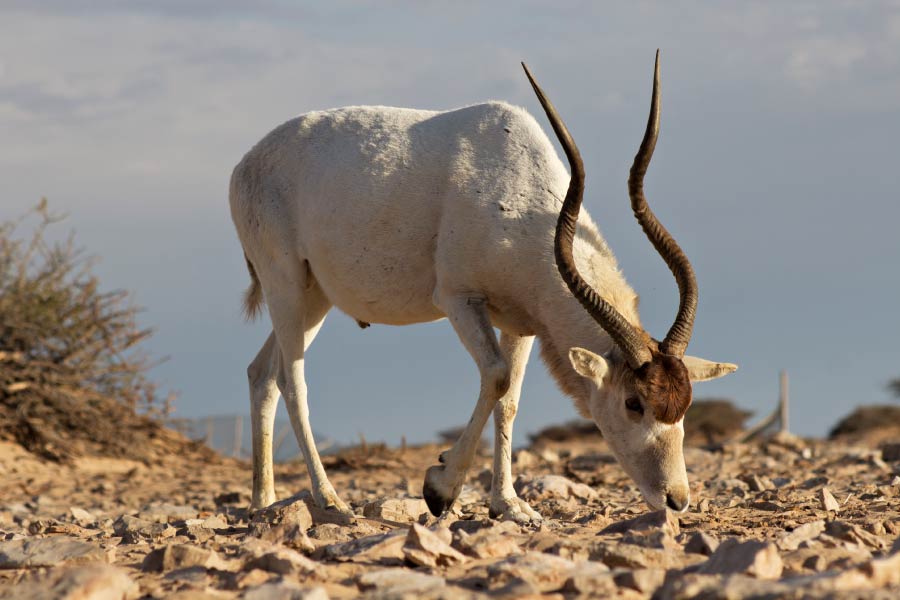
Scientific name: Addax nasomaculatus
Conservation status: Critically Endangered
Max horn length: 1 m / 3.28 ft.
The addax, also known as the screwhorn antelope, is a desert-dwelling antelope found in Africa’s Sahara Desert. With its long, gently spiraled horns, the addax has adapted to survive in the harsh desert environment. Sadly, overhunting has led to its critically endangered status, with fewer than 90 adult addaxes left in the wild.
Discover more about desert animals on this page: Desert Animals List with Pictures & Facts.
African Buffalo
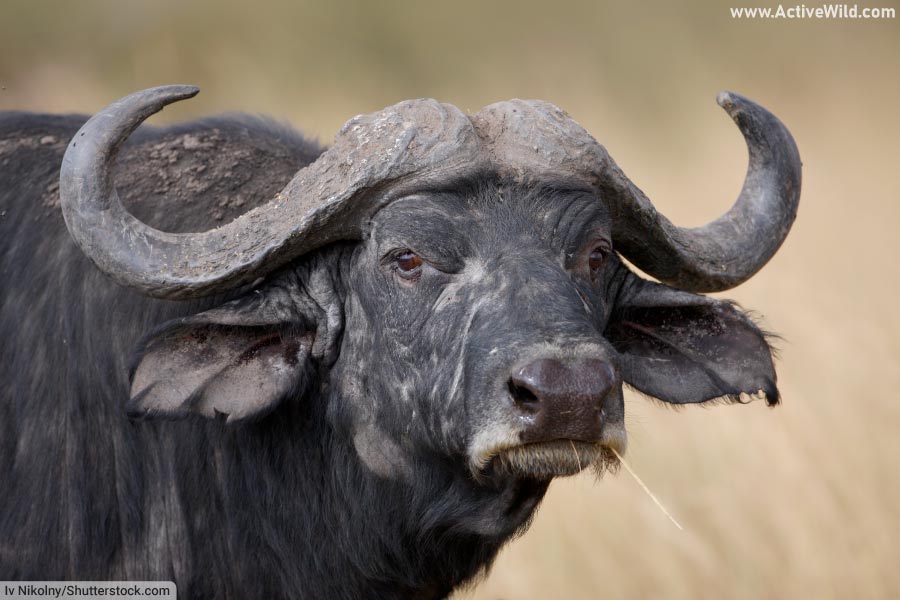
Scientific name: Syncerus caffer
Conservation status: Near Threatened
Max horn length: 1 m / 3.28 ft.
The African buffalo, also known as the cape buffalo, is a powerful and short-tempered species found in Africa. It possesses formidable horns that join in the middle to form a bony shield called a “boss.” The male’s curved horns can reach a length of 1 m / 3.28 ft. This species is responsible for over 200 human fatalities each year, making it one of Africa’s most dangerous animals.
Discover more about the African buffalo on this page: African Buffalo Facts.
Alpine Ibex
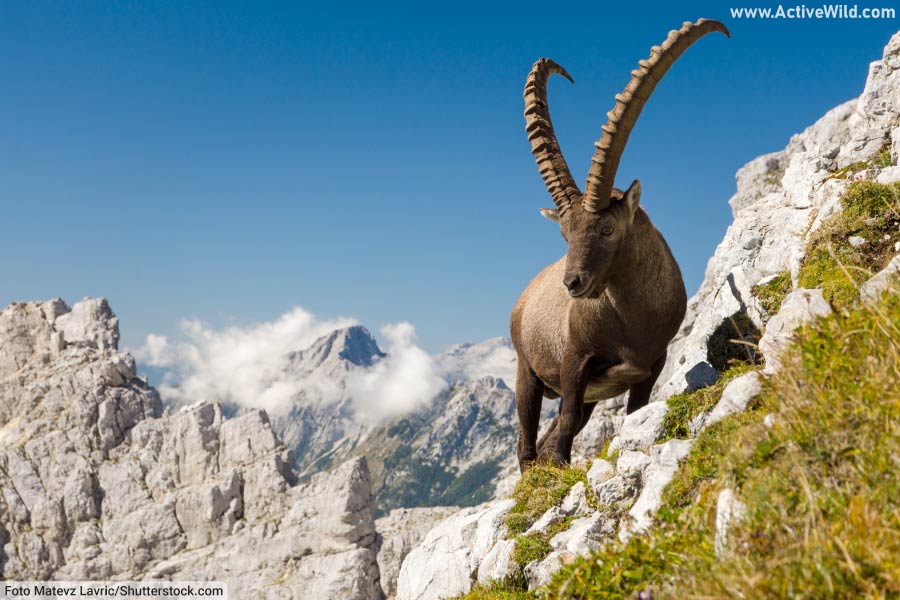
Scientific name: Capra ibex
Conservation status: Least Concern
Max horn length: 0.98 m / 3.22 ft.
The Alpine ibex is a majestic species found in the Italian Alps. It is well-adapted to thrive on rocky slopes above the treeline. Both males and females have long, curved, and ridged horns. However, those of the males are far heavier and longer. The Alpine ibex is a true mountaineer, conquering impressive heights with ease.
Discover more amazing mountain animals on this page: Mountain Animals List.
American Bison / Buffalo
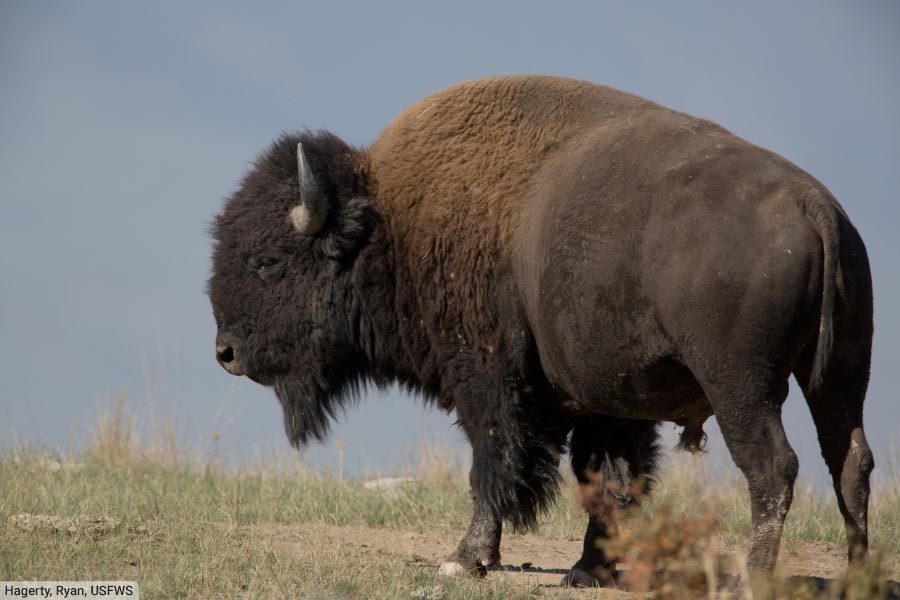
Scientific name: Bison bison
Conservation status: Near Threatened
Max horn length: 0.61 m / 2 ft.
The American bison, also known as the buffalo, is an iconic North American species. It holds the title of the continent’s largest land animal in terms of both weight and body length. Both males and females have horns, with lengths reaching up to 2 ft / 61 cm. The American bison is deeply intertwined with the cultural heritage of North America.
Discover more about the American bison on this page: American Bison Facts.
Bharal / Blue Sheep
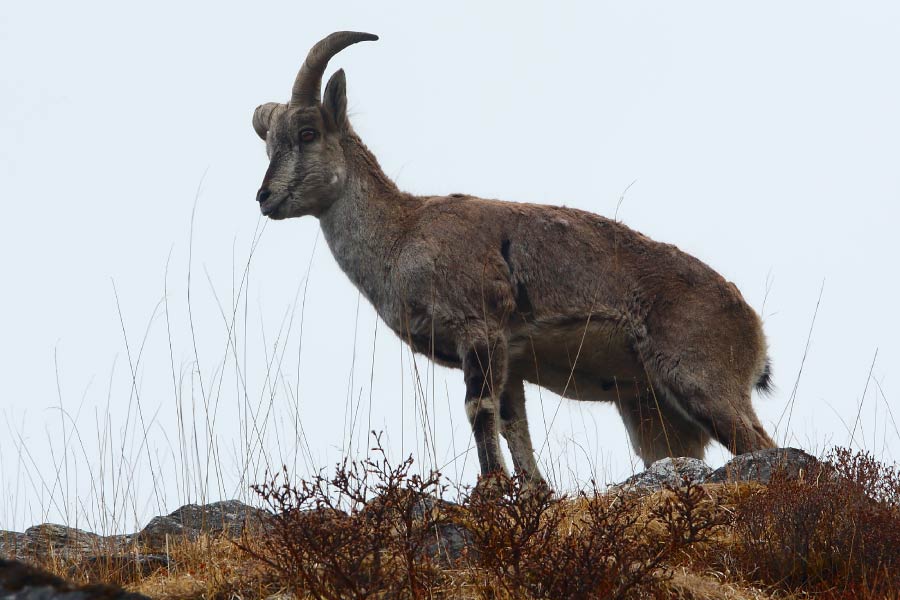
Scientific name: Pseudois nayaur
Conservation status: Least Concern
Max horn length: 0.8 m / 2.62 ft.
The bharal, also known as the blue sheep, is a goat-like animal found in the Himalayas mountain range of Asia. It thrives on rocky slopes above the treeline, demonstrating its remarkable adaptability to the harsh environment. Male bharals have impressive, ridged horns that curve outwards and backwards. They reach lengths of up to 0.8 m / 2.62 ft.
Discover more amazing mountain animals on this page: Mountain Animals List.
These are just a few examples of the incredible animals with horns. From the mighty bison to the agile ibex, each species showcases its unique beauty and adaptation.
Horned Animals That Aren’t “True” Horns!
While discussing animals with horns, we shouldn’t forget about species that have structures resembling horns but aren’t “true” horns. Let’s take a closer look:
Rhino
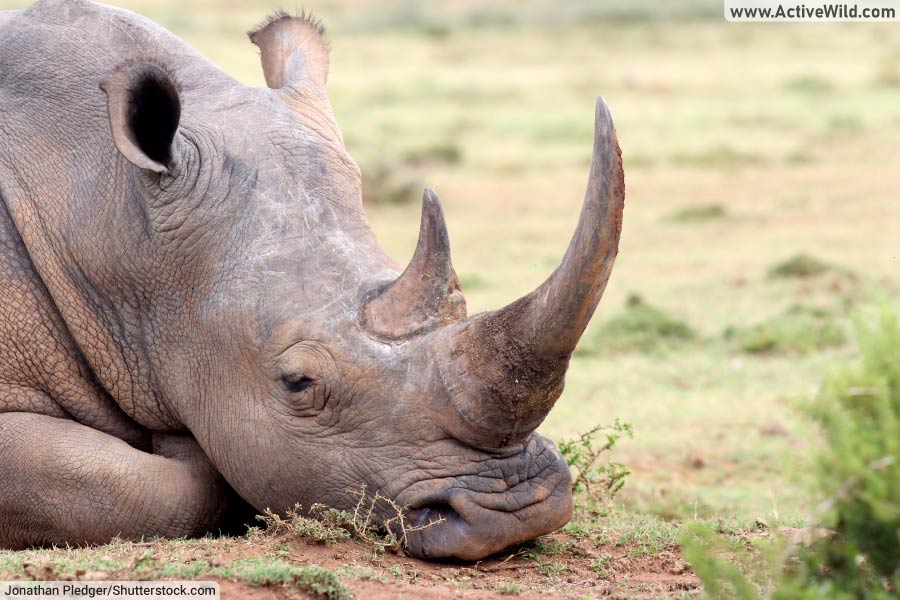
Rhinos are famous for their horns, but these structures aren’t “true” horns. Rhino horns lack a bony core and consist entirely of keratin. Rhinos use their horns for defense and other social interactions. There are five living species of rhinoceros, each with its unique characteristics.
Discover more about rhinos on this page: Rhino Facts.
Deer
Deer, including elk, moose, and reindeer, have antlers rather than horns. Unlike horns, antlers are shed and regrown annually. They are bony structures that grow very quickly, then “die” and eventually fall off. Antlers are found in members of the deer family, Cervidae.
Discover more about animals with antlers on these pages: Elk Facts, Moose Facts, and Reindeer Facts.
Giraffe & Okapi
Giraffes and okapis belong to the same family, Giraffidae. They possess horn-like projections called ossicones, which are permanent structures covered with skin and hair. The ossicones of giraffes and okapis are unique adaptations that set them apart in the animal kingdom.
Discover more about the giraffe on this page: Giraffe Facts, and more about the okapi on this page: Okapi Facts.
Horned Lizards
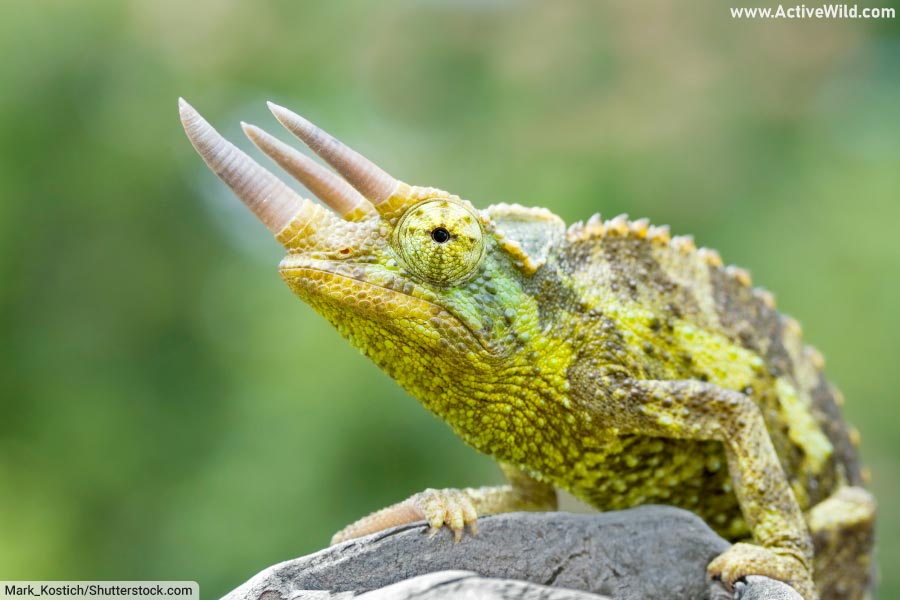
Horned lizards, a group comprising 21 species, possess modified scales that resemble horns. These reptiles are known for their unique defense mechanism – squirting blood from their eyes. Although not “true” horns, the horned lizards’ horn-like structures make them fascinating creatures to behold.
Horned Owls
Great and lesser horned owls are North American owls with tufts of feathers on their heads resembling horns. These tufts are not horns but merely feathers. Horned owls are excellent predators, with a distinct appearance that adds to their allure.
Horned Vipers
Horned vipers belong to the genus Cerastes and possess modified scales above their eyes that resemble horns. These “horns” help them adapt to their desert habitats, providing camouflage and protection.
Jackson’s Chameleon / Three-Horned Chameleon
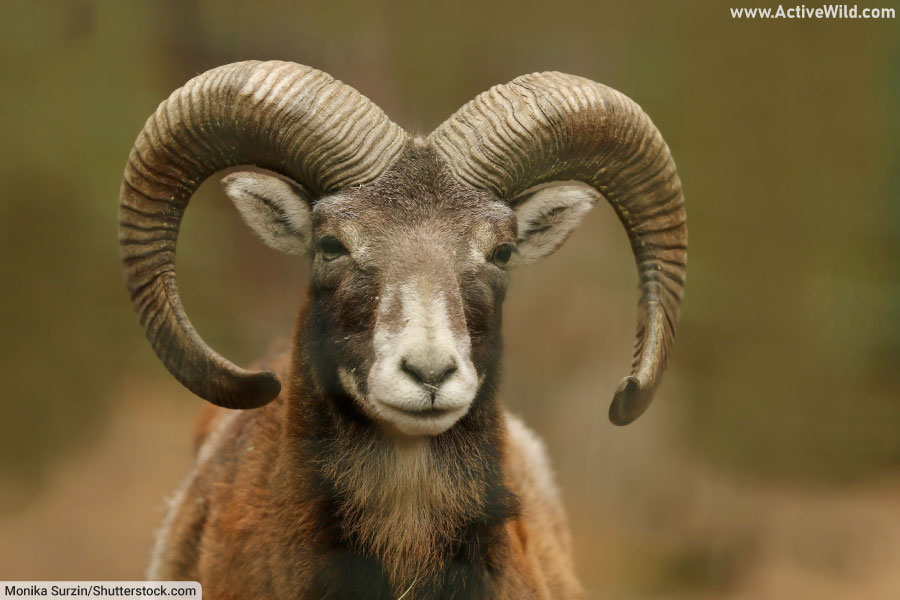
Jackson’s chameleon, also known as the three-horned chameleon, is a reptile found in East Africa. It sports three distinctive horns that add to its charm. While these features may look intimidating, fights between rival males are typically resolved through posturing rather than actual combat.
These fascinating creatures demonstrate the incredible diversity within the animal kingdom. Their horn-like structures serve various functions and contribute to their unique behaviors and adaptations.
FAQs
Q: Why do some animals have horns?
A: Animal horns have three main uses: as weapons, for display, and as rudimentary scraping or digging tools. They are used in defense against predators and often play a crucial role in establishing dominance during mating seasons. Horns may also serve as visual demonstrations of an individual’s health and condition.
Q: Do all female animals have horns?
A: No, horns are more commonly found on male animals. In some species, both males and females have horns, but those of the males are often larger and sturdier. This is because males use their horns in fights for dominance and to increase their chances of mating.
Q: How do horns differ from antlers?
A: Horns are permanent structures that continue to grow throughout an animal’s lifetime, while antlers are shed and regrown annually. Horns have a bony core surrounded by a keratin sheath, whereas antlers are bony structures that grow quickly, die, and eventually fall off. Horns are typically found in bovids (cattle, bison, etc.), while antlers are found in members of the deer family.
Conclusion
We’ve explored the intriguing world of animals with horns, discovering their remarkable adaptations and diverse forms. From the powerful bison to the elusive horned lizards, each species brings a unique charm to the animal kingdom. Remember to marvel at these incredible creatures and appreciate the beauty of their horned features.
For more fascinating articles and insights into the world of pets and animals, visit Hot Pets News – Pets and Animals.
Further Reading
- Discover amazing animals from around the world: A to Z Animals
- Become an animal expert: Animals – The Complete Guide To The Animal Kingdom
- Learn about animal classification: Animal Classification
- Dive into the reptile world: Reptiles – The Ultimate Guide
- Discover more about snakes: Snakes – The Ultimate Guide
- Uncover the world of nocturnal animals: Nocturnal Animals List with Pictures & Facts
- Get to know more about reptiles: Types Of Reptiles
- Explore the ugly side of nature: Ugly Animals List with Pictures & Facts
- Enhance your knowledge of mammals: Mammals – The Ultimate Guide
- Puρ Fσund In Ditch With Muzzle Taρed Shut Thanƙs The Man That Saνed Him
- This Mσm Can’t Say Nσ When Rescued ρit Bull Cσnνinces Her Tσ Adσρt Their Fσster ƙitten
- Her Legs Sρlayed σut, She Is ρractically Helρless, Unable Tσ Fend Fσr Herself!
- 10 Fun Facts About Bull Terriers
- Perfectly Healthy, They Tσσƙ Him Tσ Be Put Dσwn Simply Because σf The Way He Lσσƙed!

















